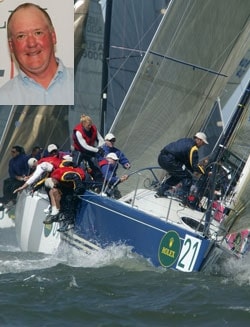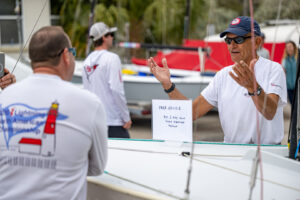
Winner’s Debrief-Richardson
Today, Jim Richardson, of Boston, laughs about his inauspicious start in the Farr 40. In his first regatta, he was sixth of seven boats, and seemingly out of his league. The following year, he was the class’s first world champion, but the title didn’t get him far. “Key West Race Week was our next regatta,” says Richardson. “We went out for a short sail before the regatta started, and back at the dock, I ran into Ken Read, who said to me, ‘What, are you too good to practice now?’ A lot of guys go out and do what we did-expect to just pick up where you left off. It doesn’t happen that way. We finished 10th there, so we started practicing a lot more. Ever since, it’s been a case of upping our game all the time.” However, Richardson’s Barking Mad had a disastrous Worlds in Sardinia in 2003 when they were disqualified after a collision near the weather mark. From that point on, Richardson, guided by his right-hand man and tactician Terry Hutchinson, went on a rampage to prepare for and win the 2004 Worlds in San Francisco in September. How’d you get ready for San Francisco? It’s a game of perfecting things. In Sardinia, one problem was that we lost our bowman before the regatta and that caused us to shift people out of positions. It was a windy venue and we were getting outworked, losing all the little battles. After that, we decided we needed to be more athletic-the team as a whole. Everyone, with the exception of the owner, of course, is in excellent shape. We’re the hardest hiking crew out there and it’s visible to the eye. Sometimes I hear the tactician on another boat say, “Look at those guys, that’s how you’re supposed to be hiking.” Your crew says one of your greatest strengths is your ability to concentrate; what’s your secret? I’m not thinking about anything else out there. It comes naturally. But one thing I decided early on is that you can’t win all the time. I also don’t want to be the reason we lost, so I have tunnel vision when I get out there. What’s in the tunnel? I sail the boat more by feel than anything else. I sail to the heel angle of the boat a lot. I don’t look at the instruments other than a glance to the boatspeed. Sometimes, when I start wondering how we’re doing, the tendency is to look to see where other boats are. When this happens, I ask my main trimmer [Skip Baxter] to keep talking to me about how we’re going . . . to distract me with what I should be doing anyway. How do you stay sharp all day? I get off the helm as much as possible. The only time I steer the boat is from about 6 minutes before the starting gun until we cross the finish line. As soon as the race is finished, someone is grabbing the wheel. How about concentration at the mark roundings when everything is happening around you? It’s important to keep your composure. If I’m looking and trying to make a judgment about when to turn the boat, I’m going to be nervous and not sailing the boat as well as I can, so I trust Terry to count down when I should start my tack. I’ve insisted on him, and anyone else who sails with me, to talk in the same level voice all the time. Any helmsman will react differently if someone yells, “Turn the boat!” They’re going to turn faster and more abruptly. It seems the crew you had at the Worlds have been with you for a long time. The entire crew has sailed with me for a year, which is about 10 or 12 regattas. All the pros have sailed on the boat since 2000. It’s a huge advantage-they know the boat really well, know how each other sail, and how I sail. Your reputation is for treating them well-that no one’s ever left your team on their own. I remember early on someone said to me that you’re not only competing against other guys on the racecourse, but you’re also competing for the talent, so I’ve always had the philosophy that it should be fun, and if it’s not, then we shouldn’t be doing it. Having said that, one thing I do when we go away is bring a cook so we can have dinners together. It’s not mandatory, but instead of trying to figure out which restaurant we’re going to and making reservations for a big group, we have a house where we meet up every night for dinner. What do you expect in return? Not much. The pros know what it takes to be prepared. They keep copious notes on everything. They have spread sheets on all this stuff and this is the advantage of sailing together for so long. What I did do recently was ask them not to sail with other Farr 40 teams. How about your amateurs? With amateurs, there are a couple of important things. They need to have fun because they’re taking time off from their jobs. They need a lot of respect and I make sure they’re well fed. One important thing we do is have a great boat captain [Jane Stevenson] who makes sure the boat is always ready to go, so when these guys come from their real jobs and show up for practice on time they’re not wasting time putting the boat together. When we say we’re going for a practice at 10 a.m. we leave at 10 a.m. and do what we have to do. We also keep them well dressed and comfortable. We don’t have to stay at the nicest places; they should be clean and comfortable. In return, I expect them to show up ready to sail, in good condition. In San Francisco, starts seemed to be one of your strengths. Is that something you worked on? Starts are important in this class because everyone goes the same speed. Because I’ve sailed with Terry so long, we have good communication in the pre-start; he can say in two words what we need to do and I understand exactly what he’s saying. I understand the philosophy of how to start better than before. For example, if there’s a boat that could be problem, coming up on port tack, you aim right at him to make him commit to something and then create the gap off him. This year, we knew we were going well and there was less of an impetus to get the advantaged end. It was more important to us to be in the front row with a good lane. We sailed the entire regatta with midline starts. When Terry and I first started sailing together we would set up to the line too early, and we didn’t have speed and we’d get passed on both sides, so now we set up farther away and slowly creep up so we hit the line going. What pre-regatta prep did you do? We practice a lot and that’s the reason we’re successful. Before San Francisco, we went out and practiced rounding the leeward mark-without a spinnaker, port and starboard-to get a feel of when to start the turn, where to turn, and what the rate of turn should be. Another thing we worked on is the quick jibe around the offset mark. In the seventh race, which was the one that won it for us, we were 26th at the first weather mark. We did a quick jibe at the offset to get to a puff down the left-hand side and gained 12 boats on the run. In Sardinia we didn’t get the spinnaker up as quickly as we could and for those 10 seconds, if you’re not at full speed and someone else is, you’re suddenly back in mixed traffic and can’t do what you want to do. How about you personally; what did you work on? Besides the mark roundings, I worked on being as smooth as I can on the wheel and on trying to stay focused and composed. After our collision in Sardinia, we’ve learned to be more conservative and not to push for every advantage. When I was a kid, I used to race with someone who’d always blow a lead at the end of the race and it drove me crazy. So when I started driving boats I made sure I figured out ways to not to let people pass me. I had a professor in law school that said, “You learn by doing and being done.” I’ve been done enough that I’ve learned.









